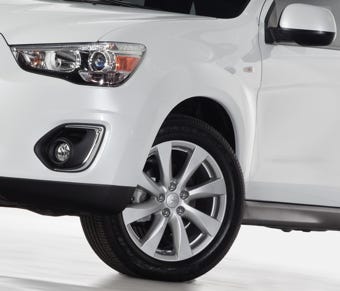Japanese automaker Mitsubishi Motors Corporation (MMC) is molding front fenders for its 2013 Outlander Sport crossover in a two-cavity tool. Besides the weight savings, and thus fuel economy, realized by using Noryl GTX 989 resin from SABIC's Innovative Plastics business (Pittsfield, MA) instead of steel, the industry's first two-cavity mold for molding fenders allows MMC to cut cycle times in half and reduce tooling costs.
November 19, 2012
Japanese automaker Mitsubishi Motors Corporation (MMC) is molding front fenders for its 2013 Outlander Sport crossover in a two-cavity tool. Besides the weight savings, and thus fuel economy, realized by using Noryl GTX 989 resin from SABIC's Innovative Plastics business (Pittsfield, MA) instead of steel, the industry's first two-cavity mold for molding fenders allows MMC to cut cycle times in half and reduce tooling costs.
|
Plastic fenders reduce vehicle weight by 3 kg, |
Furthermore, the molded components are the first North American fenders with integrated pedestrian head impact absorption brackets. Noryl GTX 989 is a conductive blend of polyamide (PA) and modified polyphenylene ether (PPE).
"Mitsubishi Motors is the first automotive OEM to use the new Noryl GTX resin grade, which speaks to the progressiveness of the company with new strategies that multiply the performance and cost benefits of thermoplastic fenders," said V. Umamaheswaran (UV), director of marketing, Automotive, Innovative Plastics. "By combining the performance enhancements of Noryl GTX 989 resin with the efficiency and speed of two-cavity molding, Mitsubishi Motors has taken a major step forward in automotive fender innovation."
By adopting two-cavity injection molding for the Outlander Sport's front fender, which allows both the left and right fender components to be produced in one shot, MMC was able to largely cut cycle time. In addition, this approach significantly reduced capital costs because only one tool was created rather than two separate tools.
This application, the first automotive body panel using Noryl GTX 989 resin, leverages the improved mechanical performance of the material, which is a conductive blend of polyamide (PA) and modified polyphenylene ether (PPE). Compared to the previous grade, Noryl GTX 989 resin delivers a 10°C improvement in heat tolerance, making it a candidate for use in higher-temperature online painting. The next-generation Noryl GTX 98X series materials also reduce the coefficient of linear thermal expansion (CLTE) by 10 percent vs. previous grades for increased dimensional stability and improved gap and flush management, giving automotive designers freedom to create larger, high-precision body panels.
MMC took full advantage of this enhanced design freedom to integrate energy-absorbing brackets into the fender to improve pedestrian protection. Validation studies indicated a head injury criterion (HIC) value for the Noryl GTX resin fender that was 25 percent lower than a comparable steel fender.
The use of Noryl GTX resin instead of steel for the Outlander Sport fenders reduced vehicle weight by 3 kg (approximately 7 pounds). This weight reduction is particularly important in view of the recently announced U.S. fuel economy rules, which essentially double the mileage requirement for OEM fleets.
According to SABIC's Sustainable Product Scorecard, verified by GreenOrder, a leading sustainability consulting firm, the use of the Noryl GTX 989 resin vs. steel in body panels can result in 45% less energy consumption and 47% less carbon dioxide (CO2) emissions per fender over the vehicle's entire lifecycle.-[email protected]
About the Author(s)
You May Also Like



